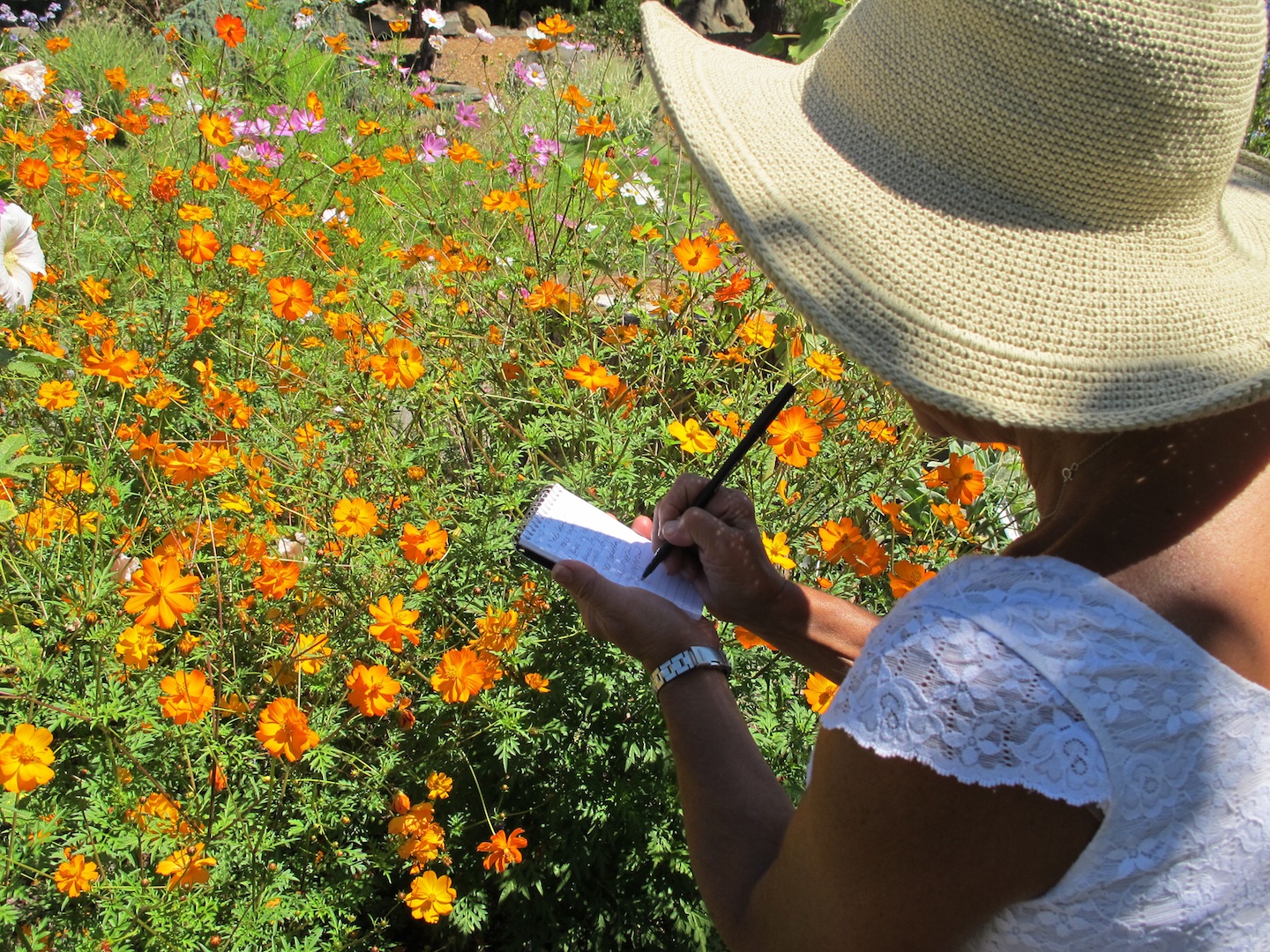
Celeste Ets-Hokin counts bees for The Great Bee Count. (Photo by John Upton.)
Celeste Ets-Hokin stood before a garden of tall flowering plants inside Oakland’s Gardens at Lake Merritt. A bevy of blooms and a series of tiny holes drilled into a nearby tree stump-turned-nest had wooed a mist of bees. The apian army sang in a collective hum as the pollination garden’s lead volunteer stared at her wristwatch, notepad in hand, ready for some fun.
Ets-Hokin had 15 minutes to count bees. As her watch ticked, she peered at a sun-drenched stand of cosmos flowers, spotting, identifying, and noting everything from tiny sweat bees to honeybees and lumbering bumblebees. Between 11:40 and 11:55 she wrote frenetically with messy handwriting like a newspaper reporter (she was so excited that she accidentally went a little over the time limit).
All 37 of the bees Ets-Hokin spotted in her counting flurry happened to be native species, which have a sweet spot for the cosmos, although European honeybees were also abundant on nearby plants. The pesticide-free, flower-rich garden provides a sanctuary for all kinds of bees, which are critical for agriculture and vegetable gardens.
This timed bee-spotting exercise may sound like a game, but it’s more than that. For the past two years, thousands of volunteers have spent 15 minutes at a time counting and identifying bees for something called The Great Bee Count. Volunteers can count bees at any time, but Saturday was the project’s official national counting day. When the volunteers are done, they upload the results to an online database called The Great Sunflower Project, created by Gretchen LeBuhn, a San Francisco State University biology professor.
“When we first started, we were only having people count on sunflowers,” LeBuhn said. Since then, the number of plants that volunteers can use for their bee-counting projects has grown to include cosmos, tickseed, and a handful of other garden plants listed on the project’s website.
About 100,000 people have signed up to take part and the results of bee counts at 170 gardens were uploaded over the weekend, although LeBuhn expects more data to pour in during the coming weeks. The map posted on the project’s website currently draws on data submitted from 12,000 gardens.
Very few of those 100,000 volunteers, however, are as immersed as Ets-Hokin is in efforts to resuscitate and monitor bees. And not many were nearly as adept at identifying bees. But LeBuhn says that’s just fine.
At a time when pesticides and loss of habitat have been linked to colony collapse disorder (CCD) and native bees are also threatened, the Sunflower Project has turned concerned citizens into citizen scientists, arming bee researchers with a treasure trove of useful data.
“We measure bee traffic, which tells us whether or not plants are getting enough visits from bees so they can set fruits,” LeBuhn said. “The basic purpose is to identify the areas where bees are doing poorly and where they’re doing well so that we can direct conservation efforts.”
The results of the project so far are perhaps predictably depressing in urban settings. Bees, be they native or honey- producing, are much harder to find in cities than in rural, suburban, or wild areas. They just don’t have enough food or habitat.
Large gardens are home to more bees than small yards or potted plants, the data shows, and they like sunny areas over shade. The project has confirmed what many researchers already knew: The best place to find bees is in the desert.
The swelling set of data also shows that the quilt-works of plant patches that make up community gardens, even those inside cities, are teeming with bees. Some are honeybees that might be housed in a hive within the garden, but many others are wild foragers.
“I think that shows that by creating a diverse garden, you can really create good habitat for bees,” LeBuhn said.
Michael Pavlichek, a condominium manager who lives on a quarter-acre block in the suburban city of Livonia, Mich., counted 15 bees on a sunflower plant growing along the side of his house during Saturday’s count. He said he wanted to help after learning about the alarming fate of honeybees.
“I got a cup of coffee and I just sat down and counted the bees,” Pavlichek said. While gazing at the same patch of sunflowers on Sunday, he also noticed a hummingbird. He added: “It’s amazing what you see and hear if you take the time to stop and watch the sunflowers.”



